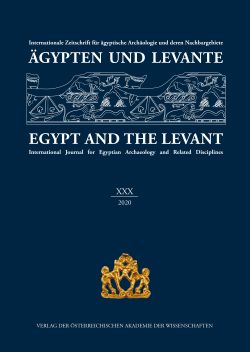Claire Malleson
S. 179 - 202
doi:
10.1553/AEundL30s179
Verlag der Österreichischen Akademie der Wissenschaften
doi:
10.1553/AEundL30s179
Abstract:
Results of archaeobotanical investigations from the 2009–2014 excavations of the joint Polish-Slovak-Egyptian mission at the site of Tell el-Retaba have previously been reported in Ä&L.2 This article provides an update and discussion of results from excavations conducted in 2015, 2016, 2017 and 2019 in Area 9, within the Third Intermediate Period settlement.3 It has been well-established that plant macro-remains are abundant and generally well-preserved at Tell el-Retaba, and they offer a wonderful opportunity to examine changing patterns in the complex relationship between plants and people over at least one thousand years. Analysis of the charred plant archaeobotanical assemblages in the town reveal that wood, sheet/goat dung, and cereal processing byproducts were all used as fuel in households, and that the animals had consumed a sedge-rich diet.
Archaeobotany, Cereal processing, Cereal chaff, Weeds, Dung, Fuel
Published Online:
2020/12/29 07:51:04
Object Identifier:
0xc1aa5572 0x003c1f6d
Rights:All rights reserved.For questions regarding copyright and copies please contact us by email.
Die Zeitschrift Ägypten und Levante wurde im Jahr 1990 von Manfred Bietak begründet, um den Forschungen zu den Kulturkontakten zwischen Ägypten und seinen Nachbarländern sowie der ägyptisch-kanaanäischen Hybridkultur, wie sie vor allem bei den österreichischen Ausgrabungen in Tell el-Dab’a zutage trat, eine Publikationsplattform zu bieten. Von Anfang an war die Zeitschrift international und interdisziplinär ausgerichtet. Das Themenfeld geht über die ursprüngliche Kernthematik weit hinaus und umfasst sowohl Vorberichte und Berichte zu archäologischen Grabungen in Ägypten und dem gesamten Vorderen Orient sowie Nubien und dem Sudan, wie auch Artikel zu allen Aspekten der ägyptischen und nahöstlichen Archäologie, Geschichts- und Kulturwissenschaft. Der Fokus liegt auf der pharaonischen Zeit, jedoch sind sowohl Beiträge zur Ur- und Frühgeschichte der genannten Regionen wie auch zur nachpharaonischen Antike möglich. Dazu wird ein weites Feld an naturwissenschaftlichen Themen abgedeckt, von Fragen der C14-Datierung über materialkundliche Untersuchungen bis hin zu archäobotanischen, archäozoologischen und anthropologischen Arbeiten.
Ägypten und Levante erscheint einmal jährlich im Druck und online. Die Redaktion ist bemüht, eingereichte Artikel möglichst zeitnah zu publizieren. Beiträge sind in Deutsch, Englisch oder Französisch einzureichen. Buchbesprechungen und Rezensionen werden nicht publiziert. Alle eingereichten Artikel werden einem internationalen peer-review Verfahren gemäß den Qualitätsstandards der Österreichischen Akademie der Wissenschaften unterzogen.
Egypt and the Levant was founded by Manfred Bietak in 1990 to provide a publication platform for the research on cultural contacts between Egypt and her neighbours. A focus of interest was the Egyptian-Canaanite fusion of cultures, which was mainly encountered at the site of Tell el-Dab’a during the Austrian excavations. From the beginning, the scope of the journal was international and interdisciplinary. The subject area has now been greatly expanded far beyond the original topics. It comprises reports and preliminary reports on archaeological excavations in Egypt and the entire Middle East including the Sudan, as well as articles dealing with all aspects of Egyptian and Near Eastern archaeology, history or cultural history. The main emphasis lays on the pharaonic period, but both contributions to prehistory of the said regions, and post-pharaonic periods may be accepted. In addition, a broad range of scientific topics is covered, including C14-dating, material analyses, archaeobotanical and archaeozoological studies as well as studies in physical anthropology.
Egypt and the Levant is published on an annual basis, both in print and online. Submitted articles are intended to be published in a timely manner. Manuscripts may be submitted in English, German or French. Book reviews are not accepted. All submitted articles are subject to international peer-review according to quality standards of the Austrian Academy of Sciences.



 Home
Home
 Print
Print
 References
References
 Share
Share
